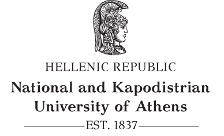- Αρχική
- THE PROGRAM
-
MODULES
- THE ARCHAEOLOGY OF BRONZE AGE AEGEAN (1010)
- KEY THEMES IN EASTERN MEDITERRANEAN ARCHAEOLOGY (1020)
- STATE FORMATION AND THE RISE OF POWER IN AN INSULAR WORLD: THE ARCHAEOLOGY OF MINOAN CRETE (3020)
- THE ARCHAEOLOGY OF MYCENAEAN GREECE (1050)
- COLLAPSE AND TRANSFORMATION: CRISIS, RESILIENCE, AND REORGANIZATION FROM THE LATE THIRD TO EARLY FIRST MILLENNIUM BCE IN THE EASTERN MEDITERRANEAN (3030)
- UNDERSTANDING THE ARCHAEOLOGICAL RECORD: PREHISTORIC CYPRUS AND THE EAST MEDITERRANEAN (2080)
- THE VISUAL CULTURES OF CLASSICAL GREECE (1030)
- ANCIENT GREEK SCULPTURE (1080)
- ATTIC POTTERY OF THE ARCHAIC AND CLASSICAL PERIODS (1090)
- THE ARCHITECTURE OF THE MYSTERY CULTS (2090)
- THE ARCHAEOLOGY OF DEATH IN THE ANCIENT GREEK WORLD (3010)
- STAFF
- ACTIVITIES
- ADMISSION
- RESOURCES
- CONTACT US
- NEWS AND EVENTS
ANCIENT GREEK SCULPTURE (1080)
Spring Semester, Optional module, 10 ECTS
Instructor: Stylianos E. Katakis
Summary
This course examines an important category of Greek art, the sculpture in the round and in relief, from the Archaic till the end of the Hellenistic period about 30 BC. The students, who will have already attested the core module “Visual Cultures of Classical Greece”, will now study thoroughly specific issues concerning the use of sculptural works as cult images, as votive offerings, as grave monuments and as part of architectural settings, as well as the way in which we can know the lost originals through copies from the Roman times.
Learning outcomes
At the end of this course students should be familiar with:
- the basic forms of Greek sculpture, their use and meaning,
- the methods of recognizing, dating and interpreting a sculpture or a group of sculptures.
- the importance of narrative scenes on architectural settings which contribute to the broader study of Greek literature, archaeology and history.
They should also be able to:
- use and combine data from different sources for a holistic study of sculpture.
- create and express their own opinions about sculpture as a means to learn more about ancient Greek society: politics, economics, everyday life, religion and cult.
Syllabus
The course examines the following topics:
- Introduction, instructions for presenting and writing assignments
- Sculpture technics: material (different kinds of marble), sculptor’s tools. Visit to the Cast Museum of the Department
- Architectural sculpture I – II
- Attic Grave Reliefs I – II
- Honorific statues
- Classical sculpture known through Roman copies
- Athens in Late Hellenistic and Roman Periods
- Presentations of students’ essays – Discussion
- Possible visit το selected archaeological Museums and sites
Assessment
Assessment is in English and can be formative and summative. During the semester, students are asked to write an essay of approximately 3.500-5.000 words on a topic related to the course content. A list of indicative topics is provided, but students are encouraged to choose and personalize the essay topic with the instructor. Each student must present his/her work to the class and answer questions from the instructor and fellow students during the discussion after the presentation. It is particularly important to submit the final text with all the comments incorporated.
Class participation: 10%
Oral presentation: 30%
Written work: 60%
The evaluation criteria are available in the course e-class and are analyzed in the first lesson.
Student's study hours
Lectures: 20
Educational visits: 6
Study and analysis of bibliography: 80
Cooperation with the instructor: 24
Independent study (incl. project): 40
Essay writing: 80
Course total: 250
Recommended bibliography
Biard, G. 2017. La représentation honorifique dans les cités grecques aux époques classique et hellénistique, BÉFAR 376. Athènes
Bol, C. ed. 2001-2007. Die Geschichte der antiken Bildhauerkunst I. Archaische Kunst; II. Klassische Kunst; III. Hellenistiche Kunst. Mainz
Palagia, O. ed. 2019. Handbook of Greek Sculpture. Berlin
Palagia, O. and J. J. Pollitt, eds. 1996. Personal Styles in Greek Sculpture. Cambridge
Queyrel, F. 2016, 2020. La sculpture hellénistique Ι. Formes, thèmes et fonctions, IΙ. Royaumes et cités. Paris
Ridgway, B. S. 1970, 1981, 1997. The Archaic Style in Greek Sculpture, The Severe Style …, Fourth Century Styles … Fifth Century Styles … Princeton or Madison/Wis.
Ridgway, B. S. 1990, 2000, 2002. Hellenistic Sculpture. I, II, III. Madison/Wis.
Smith, R. R. R. 1991. Hellenistic Sculpture. London
Spivey, N. 1996. Understanding Greek Sculpture. Ancient Meanings, Modern Readings. London
